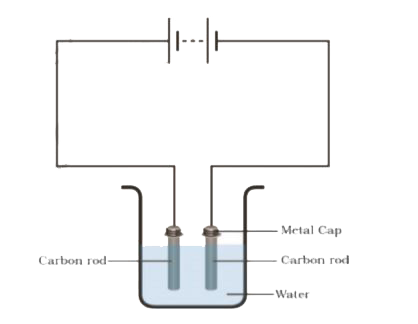What happens when electric current is passed through water?
Step-by-Step Solution:
1. Understanding Water Composition:
- Water is chemically represented as H₂O, which consists of two hydrogen atoms and one oxygen atom.
2. Electrolysis Process:
- When electric current is passed through water, a process called electrolysis occurs. This process involves the decomposition of water into its constituent elements.
3. Decomposition of Water:
- During electrolysis, water (H₂O) breaks down into hydrogen (H₂) and oxygen (O₂) gases. The reaction can be summarized as:
2H₂O(l)→2H₂(g)+O₂(g)
4. Role of Electrodes:
- Electrolysis requires two electrodes: the anode and the cathode.
- The anode is the positive terminal where oxidation occurs (loss of electrons).
- The cathode is the negative terminal where reduction occurs (gain of electrons).
5. Ion Formation:
- When water is electrolyzed, it dissociates into ions:
- At the cathode (negative terminal), hydrogen ions (H⁺) gain electrons to form hydrogen gas (H₂).
- At the anode (positive terminal), hydroxide ions (OH⁻) lose electrons to form oxygen gas (O₂).
6. Observation of Gases:
- As the electrolysis proceeds, bubbles of hydrogen gas will form at the cathode, and bubbles of oxygen gas will form at the anode.
7. Conclusion:
- Thus, when electric current is passed through water, it results in the decomposition of water into hydrogen and oxygen gases, demonstrating the chemical effects of electric current.
- Water is chemically represented as H₂O, which consists of two hydrogen atoms and one oxygen atom.
- When electric current is passed through water, a process called electrolysis occurs. This process involves the decomposition of water into its constituent elements.
- During electrolysis, water (H₂O) breaks down into hydrogen (H₂) and oxygen (O₂) gases. The reaction can be summarized as:
2H₂O(l)→2H₂(g)+O₂(g)
- Electrolysis requires two electrodes: the anode and the cathode.
- The anode is the positive terminal where oxidation occurs (loss of electrons).
- The cathode is the negative terminal where reduction occurs (gain of electrons).
- When water is electrolyzed, it dissociates into ions:
- At the cathode (negative terminal), hydrogen ions (H⁺) gain electrons to form hydrogen gas (H₂).
- At the anode (positive terminal), hydroxide ions (OH⁻) lose electrons to form oxygen gas (O₂).
- As the electrolysis proceeds, bubbles of hydrogen gas will form at the cathode, and bubbles of oxygen gas will form at the anode.
- Thus, when electric current is passed through water, it results in the decomposition of water into hydrogen and oxygen gases, demonstrating the chemical effects of electric current.
Topper's Solved these Questions
- CHEMICAL EFFECTS OF ELECTRIC CURRENTBOOK - PEARSON IIT JEE FOUNDATIONCHAPTER - CHEMICAL EFFECTS OF ELECTRIC CURRENTEXERCISE - TRACK YOUR LEARNING-I
6 Videos
- CHEMICAL EFFECTS OF ELECTRIC CURRENTBOOK - PEARSON IIT JEE FOUNDATIONCHAPTER - CHEMICAL EFFECTS OF ELECTRIC CURRENTEXERCISE - TRACK YOUR LEARNING-II
6 Videos
- KINEMATICSBOOK - PEARSON IIT JEE FOUNDATIONCHAPTER - KINEMATICSEXERCISE - LEVEL 3
18 Videos
- DYNAMICSBOOK - PEARSON IIT JEE FOUNDATIONCHAPTER - DYNAMICSEXERCISE - CONCEPT APPLICATION(LEVEL 3)
15 Videos
Similar Questions
Boojho made the circuit shown in Fig. 14.10. He wanted to observe what happens when an electric current is passed through water. But he forgot to add a few drops of lemon juice to water. Will it make any difference to his observations? Explain.

View SolutionExplain what happens, when an electric current is passed through a colloidal solution ?
View Solution
Knowledge Check
What happens when an electric current is passed through a wire?
AThe wire gets coolBThe wire gets gotCThe wire gets cool first and then gets hotDNo change occursWhich of the following substances would bahave differently than the other three when electric current is passed through their solutions in water ?
AWashing sodaBAlumCSugarDCommon saltWhen an electric current is passed through acidified water, 112ml of H2 gas at NTP is collected at the cathode is 965 seconds. The current passed in amperes is
A1B0.1C0.5D2
Fill in the blanks to make true statements.
When electric current is passed through water containing a small amount of dilute sulphuric acid, then
Solutions which are decomposed due to the current passed through them are called –
View SolutionFill in the blanks to make true statements.
When electric current is passed through water containing a small amount of dilute sulphuric acid, then
— is the method of coating one metal with another using an electric current.
View SolutionWith the help of an activity explain that hydrogen and oxygen are released when an electric current is passed through water.
View SolutionElectric current is passsed through acidulated water.
View SolutionExplain what happens when :
an electric field is passed through a colloidal solution?
View Solution
